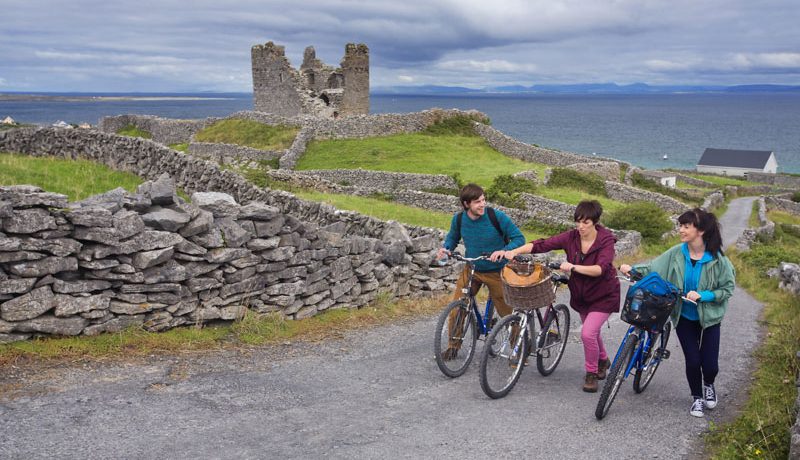Famed for its wild natural beauty, Connemara is a very popular holiday region on the west coast of Ireland. The sea and the mountains are both inescapable with no part of Connemara being far from either. The combination of the mountains, the coastline and the bog-lands provide visitors to the area with an abundance of places to see and things to do. The area has always been a popular destination for tourists and is a joy to explore and experience. It is also a perfect base from which to explore the west coast of Ireland.
We hope you get to experience everything on our list of things to see and do while in the Connemara region, but if not, you should definitely select a few!
Enjoy a Magical Day Out at Brigit’s Garden
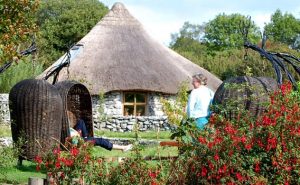 Brigit’s Garden takes you on a magical journey into the heart of Celtic heritage and mythology, making it one of the truly outstanding places to visit in the West of Ireland. The award-winning Celtic Gardens are widely regarded as one of the most spectacular in Ireland, set within 11 acres of native woodland & wildflower meadows. In addition to the Celtic Gardens visitors can enjoy the nature trail, an ancient ring fort (fairy fort), thatched roundhouse and crannog, and the calendar sundial, the largest in Ireland. Brigit’s Garden is very family-friendly with a kids’ discovery trail, a natural playground and lots of opportunity to explore. It also includes an on-site café and gift shop.
Brigit’s Garden takes you on a magical journey into the heart of Celtic heritage and mythology, making it one of the truly outstanding places to visit in the West of Ireland. The award-winning Celtic Gardens are widely regarded as one of the most spectacular in Ireland, set within 11 acres of native woodland & wildflower meadows. In addition to the Celtic Gardens visitors can enjoy the nature trail, an ancient ring fort (fairy fort), thatched roundhouse and crannog, and the calendar sundial, the largest in Ireland. Brigit’s Garden is very family-friendly with a kids’ discovery trail, a natural playground and lots of opportunity to explore. It also includes an on-site café and gift shop.
Take A Cruise to Inchagoill Island and Cong from Oughterard
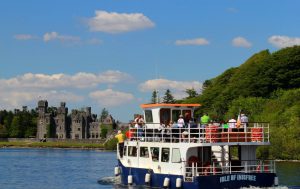 The “Corrib Queen” departs Oughterard pier daily (except Tuesdays) at 12:00pm in July & August, and on Wednesdays and Saturdays in September. This sailing takes you to Inchagoill Island on Lough Corrib. Passengers experience excellent views of the Connemara mountains and Lough Corrib’s 365 islands.
The “Corrib Queen” departs Oughterard pier daily (except Tuesdays) at 12:00pm in July & August, and on Wednesdays and Saturdays in September. This sailing takes you to Inchagoill Island on Lough Corrib. Passengers experience excellent views of the Connemara mountains and Lough Corrib’s 365 islands.
Following arrival on Inchagoill Island, passengers are given a guided tour at St. Patricks monastic site which dates back to the 5th century.
Upon leaving Inchagoill Island you will continue onto Ashford Castle in Cong, arriving there at approximately 13:30. Passengers at this point have the option of taking the 1km walk to the quaint village of Cong, famous as the location of John Ford’s 1951 classic Hollywood movie “The Quiet Man” or take the option of enjoying the beautiful grounds of Ashford Castle, former summer home of the Guinness Family. At 17:00 passengers will then board the Corrib Queen for direct transfer to Oughterard, arriving at approximately 18:00.
Visit Connemara Heritage and History Centre
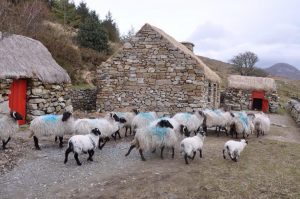 A Céad Mile Failte awaits from the Breathnach/Walsh Family at this award-winning Connemara Heritage Centre located just 6km from Clifden on the N59 in Connemara. Open from April-October, the centre is based around the restored pre-famine cottage of Dan O’ Hara who was forced to emigrate in the 1840’s when he was evicted from his home. Guided tours are both entertaining & educational and offer demonstrations of traditional farming activities such as turf cutting, sheep herding, soda bread making on the open fire and other activities & games. It offers a unique insight into the history and heritage of this most beautiful part of the West of Ireland.
A Céad Mile Failte awaits from the Breathnach/Walsh Family at this award-winning Connemara Heritage Centre located just 6km from Clifden on the N59 in Connemara. Open from April-October, the centre is based around the restored pre-famine cottage of Dan O’ Hara who was forced to emigrate in the 1840’s when he was evicted from his home. Guided tours are both entertaining & educational and offer demonstrations of traditional farming activities such as turf cutting, sheep herding, soda bread making on the open fire and other activities & games. It offers a unique insight into the history and heritage of this most beautiful part of the West of Ireland.
The on-site restaurant is ideal for morning coffee, afternoon tea or lunch stops. There is also a craft shop, internet access & free parking available.
Take a Ferry to Inishbofin Island
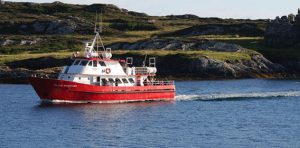 No visit to Connemara is complete without a visit to Inishbofin Island which lies 10km off the Connemara coast. The island is accessed by a 30-minute ferry crossing from the picturesque fishing village of Cleggan, just a 15-minute drive from Clifden town. Inishbofin Island is a haven of beauty, boasting magnificent scenery from cliff top walks to white sandy beaches and an abundance of rare flora and fauna at every turn. The ferry service is operated by Inishbofin Island Discovery and timetables can be found on their website.
No visit to Connemara is complete without a visit to Inishbofin Island which lies 10km off the Connemara coast. The island is accessed by a 30-minute ferry crossing from the picturesque fishing village of Cleggan, just a 15-minute drive from Clifden town. Inishbofin Island is a haven of beauty, boasting magnificent scenery from cliff top walks to white sandy beaches and an abundance of rare flora and fauna at every turn. The ferry service is operated by Inishbofin Island Discovery and timetables can be found on their website.
Surround Yourself with Nature at Connemara National Park
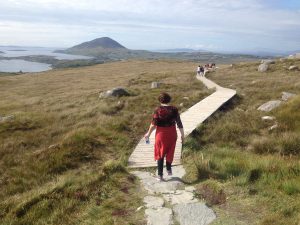
The Connemara National Park is situated in North West Connemara and covers some 2,957 hectares of scenic mountains, expanses of bogs, heaths, grasslands and woodlands. Within the park is a Visitor Centre and Tea Rooms, nature trails, woodland walks, children’s playground and the very popular Diamond Hill walking routes which offer panoramic views of the Connemara countryside and coastline. Native species of birds and animals can be seen and the largest mammal in the park is the native Connemara pony.
Admission is Free into the Park, Visitor Centre, Audio Visual Theatre and all events. The Visitor Centre is open daily, 9am to 5.30pm from March to October. The park grounds are open daily 9.00am-5.30pm all year round.
Visit Kylemore Abbey & Victorian Walled Gardens
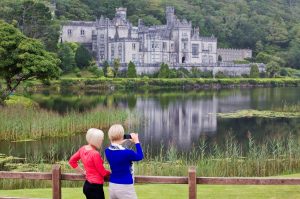 As well as the being an iconic building in a beautiful location, Kylemore Abbey is also home to the Sisters of the Benedictine Order, in Ireland, since 1920. Today it is still a working Abbey where the sisters live, work, pray and welcome visitors from around the world. Take a guided tour of the Abbey, visit the Victorian Walled Gardens and enjoy a well-earned break in the wonderful on-site café and restaurant.
As well as the being an iconic building in a beautiful location, Kylemore Abbey is also home to the Sisters of the Benedictine Order, in Ireland, since 1920. Today it is still a working Abbey where the sisters live, work, pray and welcome visitors from around the world. Take a guided tour of the Abbey, visit the Victorian Walled Gardens and enjoy a well-earned break in the wonderful on-site café and restaurant.
Hidden in the woods you will also find the stunning Gothic Church built for Margaret Henry the woman who inspired the building of Kylemore Castle in the late 1860’s. Her husband Mitchell Henry was an entrepreneur, surgeon, politician and social reformer who transformed this area of bog land in the desolate west into a virtual paradise of comfort and innovation in the 1800’s. Tragically Margaret died at the age of 45 while on holiday to Egypt in 1874. Henry returned to Kylemore where he lived until 1903 and was finally laid to rest by Margaret’s side, in the little mausoleum on the grounds of the Estate.
Cruise the Killary Fjord
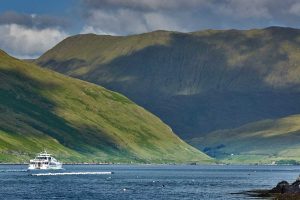 Don’t miss the popular Killary Fjord Boat Tour while visiting the Connemara region. Available daily from April – October, the tour takes 90 minutes and starts at Nancy’s Point, just west of Leenane Village. From this point the ferry sets off towards the mouth of the Fjord. The tour offers unrivalled views of the surrounding landscape with the majestic hills rising steeply from the sea. Watch out for the dolphins when you reach the mouth of the fjord as this is the point when they typically emerge if they are in the vicinity. They like to swim alongside the boat and sometimes put on a spectacular show!
Don’t miss the popular Killary Fjord Boat Tour while visiting the Connemara region. Available daily from April – October, the tour takes 90 minutes and starts at Nancy’s Point, just west of Leenane Village. From this point the ferry sets off towards the mouth of the Fjord. The tour offers unrivalled views of the surrounding landscape with the majestic hills rising steeply from the sea. Watch out for the dolphins when you reach the mouth of the fjord as this is the point when they typically emerge if they are in the vicinity. They like to swim alongside the boat and sometimes put on a spectacular show!
Go Gold Panning at Glengowla Mines
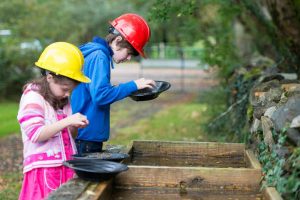 The Glengowla Mines are situated 3km west of Oughterard village on the N59 Galway – Clifden road. Here you can join in on a unique, guided, underground tour of Connemara’s only show mine and Museum. The mines, abandoned in 1865, are a unique reminder of the 19th Century methods of ore extraction and processing. The mine is noted for its rare and beautiful octahedral crystals of fluorite and quartz. Entry to the mine offers a guided underground mine tour, entrance to the museum, an explanation on how Glengowla contributes data to the Irish Seismology Network and you can also try your hand at gold panning.
The Glengowla Mines are situated 3km west of Oughterard village on the N59 Galway – Clifden road. Here you can join in on a unique, guided, underground tour of Connemara’s only show mine and Museum. The mines, abandoned in 1865, are a unique reminder of the 19th Century methods of ore extraction and processing. The mine is noted for its rare and beautiful octahedral crystals of fluorite and quartz. Entry to the mine offers a guided underground mine tour, entrance to the museum, an explanation on how Glengowla contributes data to the Irish Seismology Network and you can also try your hand at gold panning.
Explore Derrigimlagh Discovery Point
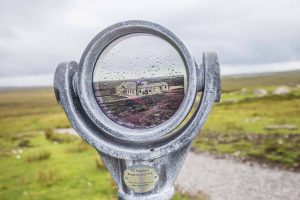 The Derrigimlagh/Marconi walking loop provides visitors with a five-kilometre trail through an area of outstanding natural beauty within the Derrygimlagh bog complex. Visitors can discover the stories of this famous site and its past history. The walk is made all the more interesting by a number of engaging and attractive features along the route, which are designed to engage visitors and encourage them to interact with the history of the location.
The Derrigimlagh/Marconi walking loop provides visitors with a five-kilometre trail through an area of outstanding natural beauty within the Derrygimlagh bog complex. Visitors can discover the stories of this famous site and its past history. The walk is made all the more interesting by a number of engaging and attractive features along the route, which are designed to engage visitors and encourage them to interact with the history of the location.
Steeped in history, The Derrygimlagh blanket bog, close to Clifden, is a rugged and wild landscape with two major claims to fame. Pilots John Alcock and Arthur Whitten Brown crashed-landed in the bog in 1919 after completing the world’s first transatlantic flight. They landed close to a wireless telegraphy station which had been set up 14 years earlier by Italian inventor, Guglielmo Marconi. Today the location of the Marconi wireless station is home to a memorial cairn dedicated to the pair.
The walk is augmented by a number of attractive features which are designed to engage visitors and encourage them to interact with the history of the location.
Visit Padraic Pearse’s Cottage
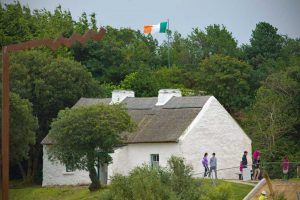 Teach an Phiarsaigh – Patrick Pearse’s Cottage is a small restored cottage that was used by Patrick Pearse (1879 – 1916), leader of the 1916 Rising, as a summer residence. The interior, although burned during the War of Independence, has been reconstructed and contains an exhibition and a number of mementoes of Pearse. The cottage was Pearse’s summer residence between 1903 and 1915. It was also as a summer school for his pupils from St Enda’s in Dublin.
Teach an Phiarsaigh – Patrick Pearse’s Cottage is a small restored cottage that was used by Patrick Pearse (1879 – 1916), leader of the 1916 Rising, as a summer residence. The interior, although burned during the War of Independence, has been reconstructed and contains an exhibition and a number of mementoes of Pearse. The cottage was Pearse’s summer residence between 1903 and 1915. It was also as a summer school for his pupils from St Enda’s in Dublin.
The historic cottage, has been developed as a national monument and tourist attraction as part of the 1916 centenary commemorations; and is a key ‘discovery point’ on the Wild Atlantic Way route.


